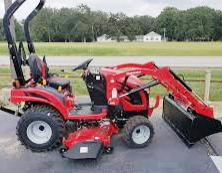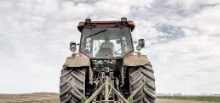________________________________________________________________________________________
| Home / Farm Tractors / Mahindra Tractors / Mahindra eMax 20S |
Mahindra eMax 20S Troubleshooting
 The
Mahindra eMax 20S is a 4WD sub-compact utility tractor. This model was
manufactured from 2017 to 2023. The components of Mahindra eMax 20 S powerline
system: a 60.6 cubic inches (1 L) Yanmar 3TNV74F vertical inline 3-cylinder
indirect injection liquid-cooled diesel engine with a rated power of 19.4 Hp
(14.5 kW), and 2-range hydrostatic transmission with infinite forward and
reverse gears. The maximum travel speed (forward/reverse): 8 mph (12.8 km/h).
The
Mahindra eMax 20S is a 4WD sub-compact utility tractor. This model was
manufactured from 2017 to 2023. The components of Mahindra eMax 20 S powerline
system: a 60.6 cubic inches (1 L) Yanmar 3TNV74F vertical inline 3-cylinder
indirect injection liquid-cooled diesel engine with a rated power of 19.4 Hp
(14.5 kW), and 2-range hydrostatic transmission with infinite forward and
reverse gears. The maximum travel speed (forward/reverse): 8 mph (12.8 km/h).
The open center hydraulic system includes a gear pump with rated fluid flow of 4.8 gal/min (18.2 l/min). The Mahindra eMax 20S is equipped with a hydrostatic power steering system, hydraulic wet disc brakes, 18x8.50-10 front tyres, and 26x12.00-12 rear tyres. The wheelbase is 53 inches (1345 mm). The tractor is compatible with a 54" mid-mount 3-blade side discharge Mahindra M54 mower deck with cutting height of 1-4" (25-102 mm), and Mahindra eMax 23L front end-loader with a maximum lift height of 71.3" (1810 mm).
| Engine Troubleshooting |
| Engine difficult to start or won't start |
Air in fuel system - Bleed fuel system.
Fuel filter element clogging - Clean or replace the filter.
Fuel injection nozzles are clogged or faulty - Change fuel injection nozzles.
Dirt or water in fuel system - Drain water or flush dirt from the system.
Valve clearance is not correct - Correct valve clearance needs to be set.
Fuel injection pump damage - Change or repair the pump.
| Diesel starts but stalls suddenly |
Clogged air filter - Clean or replace the element.
Fuel filter element is dirty - Clean the filter or install new filter element.
Problems with fuel injection pump tightness - Inspect fuel injection pump for leaks.
Defective fuel injectors - Clean or replace fuel injectors.
Damaged fuel injection pump - Repair or change injection pump.
| Engine stalls after running |
Engine is cold - Normalize the temperature by warming up the engine.
Fuel filter plugging - Service or replace the filter.
Air in the fuel lines - Bleed the fuel lines.
Fuel injection nozzles are damaged or dirty - Clean or replace injection nozzles.
Improper setting of fuel injection pump timing - Set up as recommended.
| Engine stops at low idle speed |
Low idle speed setting is not correct - Need to adjust idle speed.
Damaged fuel injection pump - Repair or install a new fuel pump.
Fuel injectors are dirty or defective - Clean fuel injectors or change it.
The valve clearance is incorrect - Correct valve clearance.
| Engine is not running at maximum power |
Plugged air filter - Clean air cleaner element.
Damaged or dirty injection nozzles - Clean or replace injection nozzles.
Fuel injection pressure is wrong - Adjust to correct pressure.
Valve out of adjustment - Check and adjust as required.
Low idle speed setting is not correct - Adjust low idling as recommended.
Clogged fuel lines or hoses - Clean fuel hoses and lines.
Blown cylinder head gasket - Replace cylinder head gasket.
Worn or broken piston rings - Change piston rings.
| Engine overheats |
Not enough coolant - Add coolant and check the components of cooling system.
Low engine oil level - Check and refill engine oil.
Dirty radiator fins or faulty radiator cap - Clean radiator or replace cap.
Fan belt slipping or worn - Fan belt must be replaced.
Diesel engine overloaded - Shift to lower gear or reduce the load.
| Low oil pressure |
Engine oil insufficient - Need to add oil.
Oil filter element clogging - Service or replace engine oil filter.
Improper type of engine oil - Drain crankcase and refill with correct oil.
Crankshaft bearing has incorrect oil clearance - Install new bearings.
Defective oil pump - Install a new pump.
| Abnormal engine noise or knocking |
Lack of engine oil - Fill up the engine oil.
Engine is not preheated - Normalize the temperature by warming up the engine.
Fuel injection pump timing is wrong - Set the fuel pump timing correctly.
Low idle speed setting is incorrect - Normalize low idle speed.
Dirty or defective injectors - Clean or replace fuel injectors.
Faulty or misaligned connecting rod - Connecting rod must be aligned or replaced.
Pistons are broken or worn - Have pistons replaced.
| Hydrostatic Transmission Troubleshooting |
| Excessive HST transmission noise |
Insufficient oil level or contaminated oil - Add oil to the correct level or fill the transmission with fresh oil.
Speed control linkage is worn or unadjusted - Repair or adjust linkage.
Relief valve is damaged - Install a new relief valve.
Transmission overload - Load needs to be reduced.
Transmission components are damaged or worn - Change or repair defective parts.
| Lack of power |
Insufficient transmission oil - Add oil to the transmission housing.
Relief valve failure - Install a new valve.
Speed control pedal linkage is damaged or out of adjustment - Repair or adjust linkage.
| Transmission oil overheated |
Low oil level - Need to add transmission oil.
Transmission fluid filter is clogged - Service or replace the transmission fluid filter.
Clogged or damaged cooling components - Check all cooling components and repair or change if required.
Transmission overload - Reduce transmission load.
| External fluid leaks |
Damaged gaskets or seals - Install new seal or gaskets.
Internal transmission housing pressure is too high - Check transmission parts for damage or wear and replace if required.
Oil drain line is clogged - Clean or change the line.
| Hydraulics Troubleshooting |
| Hydraulic oil pressure is low |
Low hydraulic oil level - Checking hydraulic oil level and add if necessary.
Clogged hydraulic oil filter - Clean or change hydraulic filter.
Hydraulic pump failure - Replace or repair hydraulic fluid pump.
Incorrect setting hydraulic control valve - Use the correct adjustment.
Faulty hydraulic cylinder - Change or repair hydraulic cylinder.
Leaks in hydraulic pipes - Identify leaks in the system and repair it.
| Hydraulic system is overheated |
Main relief valve malfunctioning - Relief valve need to be replaced.
Improper hydraulic fluid type - Use the proper type of hydraulic fluid.
Hydraulic fluid is contaminated - Fill up with new hydraulic fluid.
Air in hydraulic system - Bleed air from hydraulic system.
| Hitch won't raise or raises slowly |
Heavy load on the hitch - Load needs to be reduced.
Low hydraulic oil level - Fill the system to proper hydraulic oil level.
Clogged hydraulic oil filter element - Replace hydraulic filter element or service if necessary.
Hydraulic pump failure - Change or repair hydraulic fluid pump.
Main relief valve malfunctioning - Relief valve must be changed.
Hydraulic spool valve block is defective - Install a new valve or repair it.
Faulty hydraulic cylinder - Install a new hydraulic cylinder or repair it.
Loose or broken suction pipe - Retighten or replace pipe.
| 3-point hitch won't lower or lowers slowly |
Incorrect setting hydraulic control valve - Use the correct adjustment.
Hydraulic cylinder failure - Replace or repair hydraulic cylinder.
Three-point hitch has not been adjusted - Adjust the 3-point hitch.
Damaged hitch rock shaft - Replace the shaft.
| Hitch drop or lift is jerky |
Air trapped in hydraulic system - Bleed air from system.
Hydraulic fluid contamination - Change hydraulic fluid.
Defective hydraulic pump - Replace or repair hydraulic fluid pump.
Faulty hydraulic spool valve - Replace or repair the valve.
Broken hydraulic cylinder - Repair or install a new hydraulic cylinder.
| Steering Troubleshooting |
| Heavy steering |
Improperly fitted or damaged steering column - Refit or change the steering column.
Air trapped inside steering system - Bleed air from system.
Not adjusted toe-in - Adjust toe-in wheels.
Tire pressure is uneven - Adjust the tire pressure.
Damaged hydraulic steering pump - Check the steering pump and replace if necessary.
Stuck or damaged steering pump control valve - Replace or clean flow control valve.
Steering oil level is low - Fill up steering oil to required level.
| Excessive steering wheel free play |
Worn steering column coupling or shaft - Replace defective component.
Steering pump not working - Replace or repair steering pump.
Steering linkage parts are loose or worn - Check and replace as required.
| Tractor pulls to right or left |
Uneven tyre pressure - Inflate the tyres properly.
Improper toe-in - Adjust toe-in wheels.
Worn or loose steering linkage joints - Check and replace as required.
Damaged or improperly adjusted or worn front wheel bearings - Replace or adjust the bearings correctly.
| Electrical System Troubleshooting |
| Battery does not charge |
Loose or corroded wire connections - Tighten or clean electrical wiring connections.
Faulty battery terminal clamps - Change terminal clamps.
Battery faulty cell - Install a new battery.
Loose or worn belt - Adjust belt tension or replace belt.
| Starter turns slow |
Low battery output - Charge the battery.
Battery won’t hold charge - Service or change the battery.
Corroded battery terminals or disconnected wires - Check wiring and clean or replace terminals.
| Starter is not cranking |
Battery is discharged or worn - Charge or replace the battery.
Wire harness is disconnected or incorrectly connected - Check wire harness and connect as required.
Low battery output - Low battery charging, charge as required.
Starter motor failure - Starter needs to be changed.
________________________________________________________________________________________
________________________________________________________________________________________
| Farm Tractors Technical Specifications |
